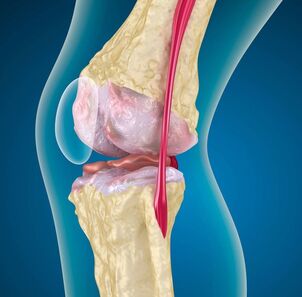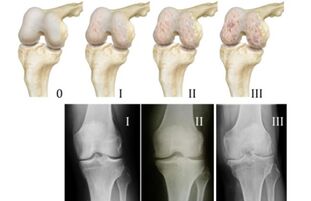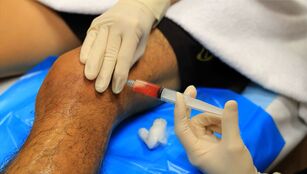GENERAL INFORMATION
Osteoarthritis of the knee is the unofficial name of the disease. In medicine, it is referred to as osteoarthritis. The word is made up of two ancient Greek words - bone and joint. Other synonyms:- deforming osteoarthritis or DOA in abbreviated form (the first word in the name reflects the main clinical symptom - joint deformity);
- gonarthrosis (from a combination of the ancient Greek words "knee" and "joint").
Sometimes the disease is mistakenly called arthritis, although traditionally this term refers to a connective tissue disease that has nothing to do with osteoarthritis.
The essence of osteoarthritis is that the cartilage tissue that lies on the surface of the joint is damaged, as a result of which inflammation begins, the work of the bone joints breaks down and pain appears. Unfortunately, this is a very common pathology, which is diagnosed mainly in older people (especially overweight) and in young athletes due to injuries.
For effective treatment, it is necessary to perform a thorough examination of the osteoarthritis patient, in particular, to identify the causes that caused the problem with the musculoskeletal system. Most often, the following factors lead to disease:
CAUSES AND SYMPTOMS
For effective treatment, it is necessary to perform a thorough examination of the osteoarthritis patient, in particular, to identify the causes that caused the problem with the musculoskeletal system. Most often, the following factors lead to disease:

- foot fractures;
- dislocation, cartilage damage, inflammation;
- impaired metabolism;
- endocrine diseases;
- weakness of the ligament apparatus;
- hereditary predisposition;
- diseases and autoimmune infections that begin damage to joint tissue.
Late admission to a doctor threatens with persistent pain in the knee area and complete loss of joint mobility.To prevent this, you should sign up for a consultation with a specialist if you have a knee crisis while walking and painful sensations that intensify when descending or climbing stairs. If treatment is not started at this stage, the situation will worsen - the pain will cease in the past, movements will become restricted and the knee will be deformed.
The longer you do not see a doctor, the more difficult it will be to treat gonarthrosis, the more time and costly.
DEGREES OF DISEASE
Osteoarthritis is diagnosed by a doctor. It not only identifies the disease but also determines its extent. There are three of them:- First. It is impossible to cure the disease in the initial stage, as at this time there are no morphological disorders of the tissues, the muscles are weakened but not yet changed, and the joint begins to tolerate the load worse due to dysfunctions of the synovial membrane and biochemical composition ofthe cavity fluid that feeds the cartilage and meniscus. Excessive use leads to inflammation and pain.
- Second. At this stage, cartilage and menisci begin to collapse, the load on them leads to pathological increase in bone tissue, narrowing of the joint space. Because of this, the knee increases in size and appears deformed. Treatment of second-degree bilateral gonarthrosis of the knee joints is already more difficult compared to the first stage. Pain and inflammation become chronic.
- Third. This degree is already considered severe. At the same time, the deformation of the bone is clearly expressed, the axis of the limb is changed, due to which the mechanical load is not distributed correctly. Ankle ligaments are shortened, natural movements are restricted due to this, and then the leg can become completely immobile. Treatment of grade 3 osteoarthritis of the knee joints without surgery is impossible, as the disease is very advanced.

If the pain seems to be tolerable for a long time, people think they have osteoarthritis only in the first stage and postpone going to the doctor. But this opinion is not correct. Every day, the load on the main elements of the joint, has already begun to collapse, increases and pathological changes can lead to complete destruction of the joints and severe dysfunction of the limbs.
CLINICAL CURRENT
Progression of the disease is accompanied by characteristic symptoms. The pain occurs in the middle of the night, even if the leg is immobile. Stiffness is felt in the morning.
Walking becomes difficult when passing a certain distance, then at the beginning of the movement. In severe cases, a person can not walk 100 meters normally, it becomes painful for him to stand and sit. You need to move with the help of special equipment.

Slight lameness in the first stage becomes more pronounced. As a result, walking, using public transportation, performing professional duties, household chores, and even self-service can become completely impossible.
TREATMENT METHODS
Folk recipes, pharmaceutical compresses and oils will not help in removing the disease, as the approach should be comprehensive.Healing is usually only possible in a hospital where a doctor will treat knee osteoarthritis.What kind of recommendations to give the patient, he decides based on the complaints shown and accompanying pathologies. The following items are usually required:
- by reducing the load on the joints;
- compliance with the orthopedic regimen;
- physical therapy (exercise therapy);
- undergoing physical therapy.
All this helps to slow down the progression of osteoarthritis and prevent loss of motor function. It should be understood that the methods used will depend primarily on the skills of the hospital and the availability of one or another physiotherapy device. It is best if the patient has the opportunity to go to a spa treatment or to a specialized orthopedic clinic, where a modern approach to the choice of medication, diet, methods, etc. will be offered.
P DRUG USE
Inflammatory processes and painful sensations make it impossible to treat osteoarthritis of the knee without medication in the form of tablets, creams, oils and injections. In the first stage, you can use non-steroidal anti-inflammatory drugs - Diclofenac, Indomethacin, Nimesulide, etc. In the second and third, you often have to fight inflammation with steroid medications - Triamcinolone, Hydrocortisone. The same hormones are used during periods of acute pain.

Furthermore, you will need to have intramuscular and intra-articular injections of drugs that improve cartilage tissue condition (vasodilators and chondroprotectors).
METHODS OF PHYSIOTHERAPY
Substantial improvements can be made using physical therapy. The following techniques are considered the most effective:
- Shock wave therapy. This method has worked well over the last 20 years. Its essence lies in the effect on the affected area with a special device that emits radial acoustic waves that activate the blood supply and stimulate tissue repair.
- Myostimulation. This therapy targets the muscles surrounding the joint. Weak current pulses increase leg mobility, relieve pain, and increase endurance during physical exertion.
- Phonophoresis. This technique harmoniously combines ultrasound therapy and the use of products in the form of oils, gels and creams. Usually, such dosage forms are absorbed by only 5-7%, but high-frequency ultrasound vibrations heat the tissues, and the absorption increases several times. In addition to the good therapeutic effect, this saves the consumption of expensive medicines.
- Ozone Therapy. The anti-inflammatory and analgesic effect can be achieved by acting on the joints with active oxygen. This is a good supplement, and in some cases an alternative to taking hormonal medication.
MEDICAL EXERCISE

Pain during physical exertion on a joint leads to the fact that the person tries to avoid it. In the long run, this threatens physical inactivity, leading to muscle atrophy and ligament weakness. Of course, during the period of deterioration, the load on the joints should be completely eliminated, but after a few days after the inflammation and pain are relieved, it is necessary to start physiotherapy exercises.
It is believed that exercise therapy exercises performed correctly and consistently can save the patient from the need for surgical intervention. Currently, experienced specialists have developed many special daily training methods that strengthen muscles and increase their strength and endurance, prevent pathological tissue destruction, restore joint movement and range of motion.
The most important thing about this type of treatment is regularity.A good effect is achieved only by those patients who understand the need for lifestyle changes and strictly follow the doctor's recommendations for the report of physical activity and periods of joint rest.
PASSIVE KINESITERAPY
Lymphatic drainage, massage, manual therapy are a good addition to medication, physiotherapy and exercise therapy. They are essential for sedentary patients and can improve the condition of their muscles, joints and ligaments.Another passive method of kinesitherapy is mechanotherapy. It uses special equipment - vibration simulators, weighing materials, mechanical massages, which increase the effectiveness of the treatment.
The elongation of the joints, in which their cavity space increases mechanically, allows you to get rid of the pain and stop the destructive processes. Regular use of this therapy prolongs knee health for years.
P COMPETITION WITH DIET
Since overweight is often the cause of osteoarthritis, patients with this diagnosis should take care of weight loss. Losing weight will reduce joint stress and facilitate exercise therapy. Sometimes diet is not enough, then bariatric surgery is required, but such situations are rare.
Another indicator of adherence to a certain diet can be any pathology associated with osteoarthritis. Unless there is obesity or other illnesses associated with the need to change eating habits, there is no need for a special diet. However, you can help the body strengthen the affected cartilage tissue by including in your diet foods rich in collagen, which include jellies and favorite meats, fish oil, berries and fruits. It is best to refrain from consuming unhealthy foods such as sugar, carbonated beverages and alcoholic beverages.
SURGICAL INTERVENTION

In advanced cases, a quick fix to problems with the musculoskeletal system is to have surgery. With osteoarthritis, the following types of surgical intervention are described:
- The piercing allows you to get rid of fluid accumulated in the joint cavity. As a result, inflammation is reduced, due to which the mobility of the knee is restored.
- Arthroscopy makes it possible to clean the surface of the wrist from pieces of damaged tissue. It is performed using thin flexible instruments using a video camera, thus avoiding dissection of the joint cavity.
- Periarticular osteotomy allows you to change the angle of one of the bones that form the knee joint, due to which the load is redistributed, mobility is increased and pain is relieved. This intervention is quite traumatic, as the bone has to be sawn.
- Endoprosthetics allows the replacement of a diseased joint with a biocompatible structure. At the same time, the range of motion of the former is restored, but the operation is quite new and very complicated, after which a long rehabilitation is required.
Surgery is rarely required in the first stage. In the second, it is necessary only sometimes, but in the third can not do without it.
PATIENT REVIEWS
Which of the many treatments will be applied in each case depends on the doctor. The specialist will choose the best method, and the patient's task is to strictly follow the orthopedist's recommendations. This is the only way to get a good result quickly. This is confirmed by patients who have been diagnosed with gonarthrosis.

























